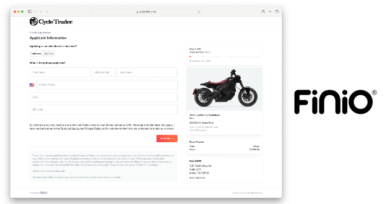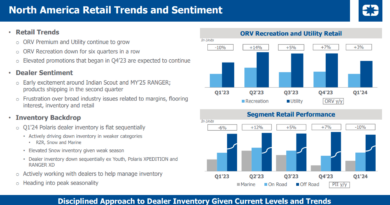Mar. 9, 2009 – A service department profit swing
By Neil Pascale
Editor
A three-pronged approach at improving service department profitability is showing huge dividends at P.J.’s Motorcycles.
The Albuquerque, N.M., dealership is involved in “The Italian Job,” a more than year-long program aimed at improving dealership profitability. The program is being run by Ducati North America and the Assurant Solutions’ 20 Clubs Division as well as being chronicled by Powersports Business. Assurant Solutions has worked since last spring to help implement best practices at the multibrand European dealership.
The effort has paid off as the dealership has shown notable improvement in its gross profit percentage. The store’s operating gross profit percentage has exceeded the national average in seven of the past nine months (The national average includes all dealerships involved in Assurant Solutions’ 20 Clubs division, formerly called the RPM Group.)
Perhaps the biggest area of change for the multibrand European dealership has been the service department, which has installed a series of processes designed to improve scheduling, identify staff shortcomings and track productivity.
“Time management has been huge,” P.J.’s Motorcycles Service Manager Mike Ames said of the new processes installed in the department. “We had virtually none before.”
Before last spring, some of the service department scheduling was done on a desktop calendar or memorized by Ames. “That was fine when there were three of us in the service department,” Ames said, noting the store’s rapid growth in the past five years. “Now it’s like, ‘OK, we have to communicate better. Everybody has to know what they’re doing rather than Mike saying, do this, do that.’”
Installing a more complete scheduling process, which could not only aid in daily planning but identify staffing shortcomings, was the first priority for Kent Meadows, an Assurant Solutions regional vice president in charge of training, when he visited the dealership last spring. During a two-day visit, Meadows introduced a “bucket system” to Ames. The system essentially uses a filling-the-bucket concept: Picture a side view of a bucket, draw horizontal lines on it so it appears like a measuring chart and then use that drawing to figure out the technicians’ day. Hence, some of the bucket would be colored in for any carryover work from yesterday, more of it would be colored in for work due to any new parts that came in overnight and then the remaining part of the bucket — whatever is not colored in — would be filled as new service work was added.
Ames used this basic system for a short time before moving his scheduling to ADP Lightspeed. Still, the bucket concept proved valuable in two ways: it ensured the dealership only sold the hours that were available on a daily basis and it showed how many hours the dealership constantly carried over. That amount totaled more than eight hours a day, meaning the dealership could have easily carried another technician.
On further inspection, the scheduling also showed one of the dealership’s master techs was spending a lot of his time on maintenance projects while more complicated jobs were getting delayed. To address this, Ames promoted a part-timer to help fill-in on the maintenance projects to free up the master tech.
Also as a result of the increased attention to scheduling, the dealership hired a service writer, something Ames, the service manager, was previously doing. Ames also was counseled to stop doing some of the tech work himself so he could concentrate on scheduling and later, tracking performance.
“You can just imagine what his life was like,” Meadows said of Ames, who at one point was service writer, shop foreman and service manager. “He was the epitome of the swirl.”
“That has been one of the most rewarding things about this whole thing,” Ames said. “Actually knowing what my job is, being able to do it and getting my guys on track. Managing this thing is not just getting everything done yourself. It’s commanding the people to get the job done.”
Besides making the internal changes, Ames also attended and graduated from Assurant Solutions’ Service Management Development Program, which teaches fundamental management tools. Those include learning how to develop real-time reports, how to forecast, how to work with his techs to ensure busy periods were correctly staffed and learning key benchmarks, like hours per RO and service productivity.
Then there was the implementation stage.
“There was definitely a little, ‘What are you doing? Why are you doing all this?’” Ames said of his staff’s reaction to the departmental changes, which included for the first time tracking technician productivity.
Ames, however, held weekly meetings as well as at times one-on-one discussions with his staff when the changes were implemented. In these meetings, Ames said he tried to get a couple of points across: “This is where we’re going, this is what I’m doing and I really want you guys to be on board and understand and support me and PJ and the dealership with this,” he said. “It’s definitely going to make everybody’s day, I won’t say easier but definitely more enjoyable, less chaotic.”
Some six months later, Ames said there is no problem with staff acceptance with the tracking, which includes daily postings of labor hours that includes a goal and actual hours per technician.
“It has been fantastic,” he said of the staff’s acceptance. “It really has.”
As have been the results.
According to Ames’ reporting, the service department produced more billable hours in December and January with one less technician. In fact, the department’s hours billed in January increased nearly 31 percent over the previous-year month despite the fact they had one less tech.
“If somebody would have asked me how many hours we billed last year a year ago, I would have had no idea,” Ames said. “But now I can tell you what we billed yesterday.
“For me, it’s about knowing where we’re at and what do we want to do tomorrow.”




